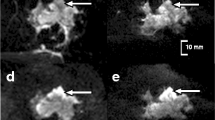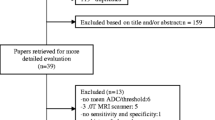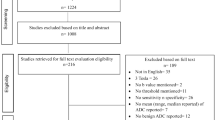Abstract
Purpose
The aim of this study was to compare diffusion-weighted imaging (DWI) at 3.0 T and 1.5 T by evaluating the apparent diffusion coefficient (ADC) value and visibility of breast cancer in the same patients.
Materials and methods
A total of 13 patients (16 lesions) with breast cancer underwent DWI at 3.0 T and 1.5 T. Tumors were classified into two groups based on the lesion size. The ADC values were measured, and visibility of the tumors was scored blindly.
Results
No significant difference was found for ADC values between 3.0 T and 1.5 T in either group (P > 0.05). All of the large lesions were visible clearly at both magnetic field strengths, and image scores were not different (P > 0.05). In contrast, small lesions were more clearly visible and had better image scores at 3.0 T than at 1.5 T (P < 0.001).
Conclusion
Small cancers were more clearly visible on DWI at 3.0 T than 1.5 T.
Similar content being viewed by others
References
Lee SG, Orel SG, Woo IJ, Cruz-Jove E, Putt ME, Solin LJ, et al. MR imaging screening of the contralateral breast in patients with newly diagnosed breast cancer: preliminary results. Radiology 2003;226:773–778.
Wobbes T, Boetes C. MRI breast-cancer screening: particularly important in women at increased risk. Ned Tijdschr Geneeskd 2006;150:1449–1453.
Morris EA, Liberman L, Ballon DJ, Robson M, Abramson AF, Heerdt A, et al. MRI of occult breast carcinoma on a high-risk population. AJR Am J Roentgenol 2003;181:619–626.
Lehman CD, Blume JD, Weatherall P, Thickman D, Hylton N, Warner E, et al. Screening women at high risk for breast cancer with mammography and magnetic resonance imaging. Cancer 2005;103:1898–1905.
Esserman L, Hylton N, Yassa L, Barclay J, Frankel S, Sickles E. Utility of magnetic resonance imaging the management of breast cancer: evidence for improved preoperative staging. J Clin Oncol 1999;17:110–119.
Shah SK, Shah SK, Greatrex KV. Current role of magnetic resonance imaging in breast imaging: a primer for the primary care physician. J Am Board Fam Pract 2005;18:478–490.
Le-Petross HT. Breast MRI as a screening tool: the appropriate role. J Natl Compr Canc Netw 2006;4:523–526.
Woodhams R, Matsunaga K, Iwabuchi K, Kan S, Hata H, Kuranami M, et al. Diffusion-weighted imaging of malignant breast tumors: the usefulness of apparent diffusion coefficient (ADC) value and ADC map for the detection of malignant breast tumors and evaluation of cancer extension. J Comput Assist Tomogr 2005;29:644–649.
Rubesova E, Grell AS, De Maertelaer V. Quantitative diffusion imaging in breast cancer: a clinical prospective study. J Magn Reson Imaging 2006;24:319–324.
Kuroki Y, Nasu K, Kuroki S, Murakami K, Hayashi T, Sekiguchi R, et al. Diffusion-weighted imaging of breast cancer with the sensitivity encoding technique: analysis of the apparent diffusion coefficient value. Magn Reson Med Sci 2004;3:79–85.
Guo Y, Cai YQ, Cai ZL, Gao YG, An NY, Ma L, et al. Differentiation of clinically benign and malignant breast lesions using diffusion-weighted imaging. J Magn Reson Imaging 2002;16:172–178.
Pickles MD, Gibbs P, Lowry M, Turnbull LW. Diffusion changes precede size reduction in neoadjuvant treatment of breast cancer. Magn Reson Imaging 2006;24:843–847.
Miao H, Fukatsu H, Ishigaki T. Prostate cancer detection with 3-T MRI: comparison of diffusion-weighted and T2-weighted imaging. Eur J Radiol 2007;61:297–302.
Toi H, Uno H, Harada M, Yoneda K, Morita N, Matsubara S, et al. Diagnosis of acute brain-stem infarcts using diffusion-weighed MRI. Neuroradiology 2003;45:352–356.
Uno M, Harada M, Takimoto O, Kitazato K, Suzue A, Yoneda K, et al. Elevation patients is associated with ischemic lesions depicted by DWI and predictive of infarct enlargement. Neurol Res 2005;27:94–102.
Kuhl CK, Gieseke J, von Falkenhausen M, Textor J, Gernert S, Sonntag C, et al. Sensitivity encoding for diffusion-weighted MR imaging at 3.0 T: intraindividual comparative study. Radiology 2005;234:517–526.
Bernstein MA, Huston J 3rd, Ward HA. Imaging artifacts at 3.0 T. J Magn Reson Imaging 2006;24:735–746.
Author information
Authors and Affiliations
Corresponding author
About this article
Cite this article
Matsuoka, A., Minato, M., Harada, M. et al. Comparison of 3.0-and 1.5-tesla diffusion-weighted imaging in the visibility of breast cancer. Radiat Med 26, 15–20 (2008). https://doi.org/10.1007/s11604-007-0187-6
Received:
Accepted:
Published:
Issue Date:
DOI: https://doi.org/10.1007/s11604-007-0187-6




